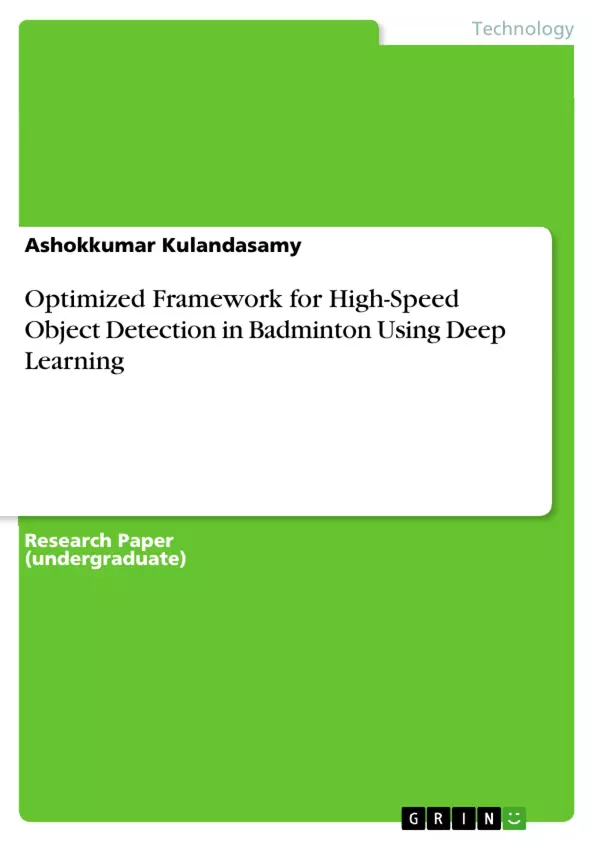Object detection is an important task in sports analysis, particularly in badminton, where the high-speed motion of the shuttlecock can make it challenging to detect. Here, we suggest a badminton high-speed object detection system using YOLO, a real-time object detection model. Our system is trained on a dataset of badminton images and videos, along with corresponding object annotations. The performance of our system is evaluated using several metrics, including mean average precision, precision, recall, F1-score, and speed. The results show that our system can achieve high accuracy and real-time performance, making it suitable for use in badminton analysis applications. Our system can be used to detect and track the shuttlecock in real-time, providing valuable insights into the game, such as the speed and trajectory of the shuttlecock, which can be used to improve the performance of players and coaches.
Inhaltsverzeichnis (Table of Contents)
- I. Introduction
- II. Related Works
- III. Materials & Methods
- Proposed Methodology
- Convolutional Neural Network
- Steps to Implementation
- IV. Results & Discussion
- Performance Metrics
Zielsetzung und Themenschwerpunkte (Objectives and Key Themes)
The objective of this work is to develop and evaluate a high-speed object detection system for badminton using the YOLO deep learning model. The system aims to accurately and efficiently detect the shuttlecock in real-time video footage, providing valuable data for sports analysis and player/coach improvement.
- High-speed object detection in badminton
- Application of deep learning (YOLO model) for object detection
- Performance evaluation using metrics like mAP, precision, recall, F1-score, and speed
- Real-time object tracking and analysis
- Contribution to sports analytics and player performance enhancement
Zusammenfassung der Kapitel (Chapter Summaries)
I. Introduction: This chapter introduces the challenges of real-time object detection in high-speed sports like badminton, specifically focusing on the difficulty of tracking the shuttlecock. It highlights the importance of object detection in sports analysis for improving player and coach performance by providing insights into shuttlecock speed and trajectory. The chapter then introduces YOLO, a real-time object detection model, as a promising solution for this problem and outlines the proposed system for badminton object detection using YOLO, emphasizing its potential for high accuracy and real-time performance.
II. Related Works: This chapter reviews existing literature on badminton object detection, summarizing various approaches and their achieved accuracies. Studies employing deep learning methods like RCNN, Faster R-CNN, and RetinaNet are discussed, along with color- and shape-based techniques. The chapter acknowledges the variability in performance based on datasets and objects of interest, setting the stage for the proposed method's contribution to the field.
III. Materials & Methods: This chapter details the proposed methodology using the YOLO (You Only Look Once) real-time object detection system. It explains the use of a single convolutional neural network (CNN) to predict bounding boxes and class probabilities. The chapter outlines the implementation steps, including data collection with object annotations (bounding boxes and class labels), model training on badminton images and videos, real-time inference using video feeds, post-processing to filter false positives, and visualization of the detections. The chapter also explains the architecture of Convolutional Neural Networks and their application to computer vision tasks. It emphasizes the resource requirements and expertise needed for successful implementation.
Schlüsselwörter (Keywords)
Badminton, object detection, deep learning, YOLO, real-time, shuttlecock, precision, recall, F1-score, mAP, sports analytics, computer vision, convolutional neural network (CNN).
Frequently asked questions about the Badminton Object Detection Preview
What is the main objective of the Badminton Object Detection project?
The primary goal is to develop and evaluate a high-speed object detection system for badminton using the YOLO deep learning model. This system aims to detect the shuttlecock in real-time video accurately and efficiently, providing valuable data for sports analysis and player/coach improvement.
What are the key themes explored in this work?
The key themes include high-speed object detection in badminton, the application of deep learning (YOLO model) for object detection, performance evaluation using metrics like mAP, precision, recall, F1-score, and speed, real-time object tracking and analysis, and the contribution to sports analytics and player performance enhancement.
What does the Introduction chapter cover?
The Introduction chapter introduces the challenges of real-time object detection in high-speed sports like badminton, focusing on the difficulty of tracking the shuttlecock. It highlights the importance of object detection in sports analysis and introduces YOLO as a potential solution.
What does the Related Works chapter discuss?
The Related Works chapter reviews existing literature on badminton object detection, summarizing various approaches such as RCNN, Faster R-CNN, RetinaNet, and color- and shape-based techniques, along with their achieved accuracies.
What methodology is detailed in the Materials & Methods chapter?
The Materials & Methods chapter details the proposed methodology using the YOLO (You Only Look Once) real-time object detection system. It explains the use of a single convolutional neural network (CNN) to predict bounding boxes and class probabilities. It also outlines implementation steps including data collection, model training, real-time inference, and post-processing.
What are some of the key words associated with this project?
Key words include Badminton, object detection, deep learning, YOLO, real-time, shuttlecock, precision, recall, F1-score, mAP, sports analytics, computer vision, and convolutional neural network (CNN).
What performance metrics are used to evaluate the system?
Performance is evaluated using metrics such as mAP (mean Average Precision), precision, recall, F1-score, and speed.
What kind of data is required for training the YOLO model?
The YOLO model requires data collected with object annotations (bounding boxes and class labels) of badminton images and videos for training.
What are the potential applications of this object detection system?
The system can provide valuable data for sports analysis and player/coach improvement by offering insights into shuttlecock speed and trajectory. It can also be used for real-time object tracking and analysis in badminton matches.
- Citation du texte
- Ashokkumar Kulandasamy (Auteur), 2024, Optimized Framework for High-Speed Object Detection in Badminton Using Deep Learning, Munich, GRIN Verlag, https://www.grin.com/document/1559605



